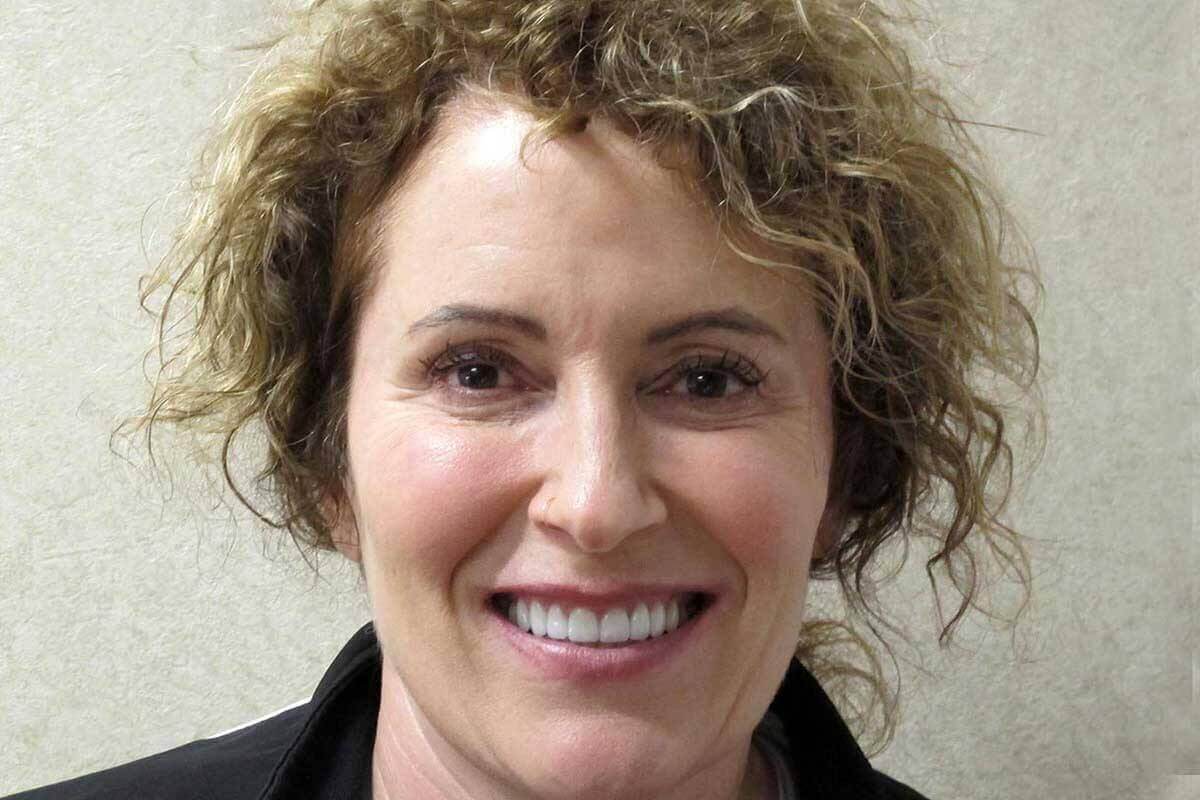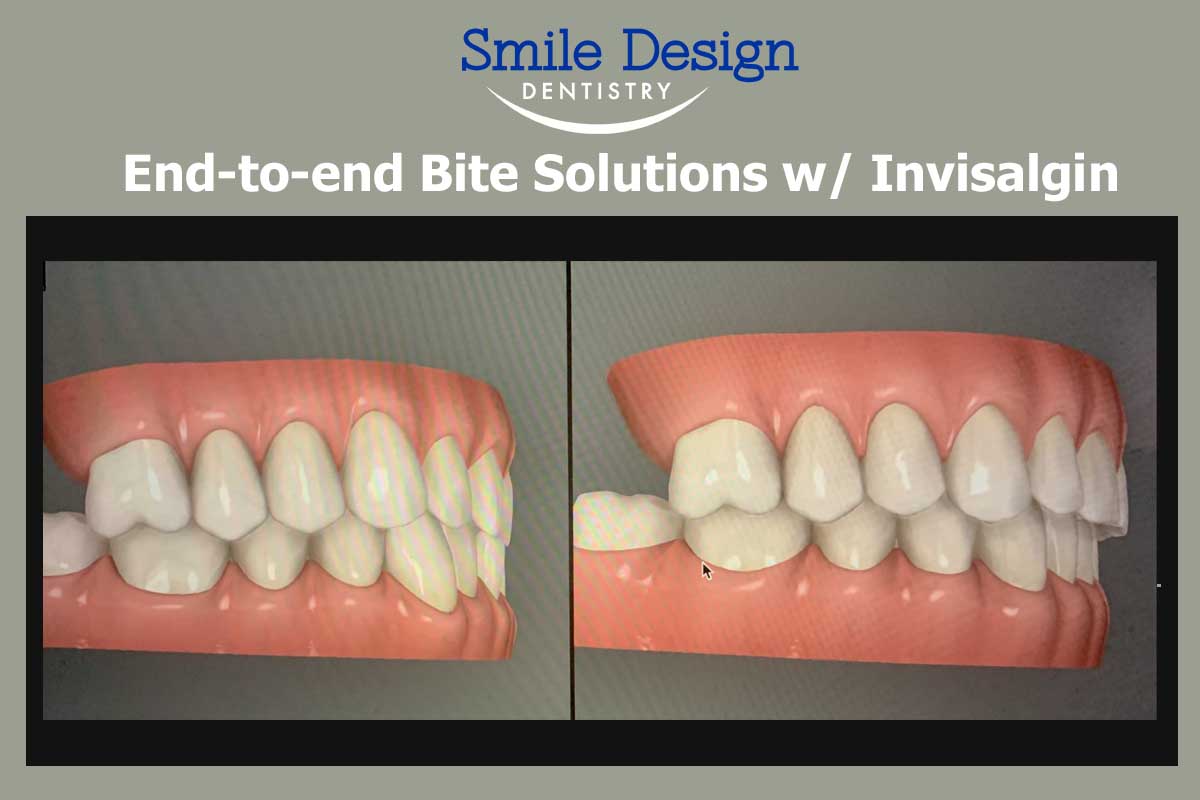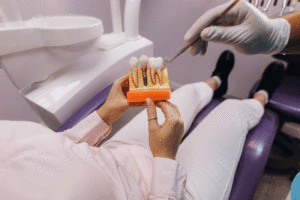The Best Invisalign® Smile Corrections Available in the 2020s
We believe that Invisalign treatment is the clear alternative to metal braces for kids, teens, and adults and is offers the best smile improvements.
Busy professional people and young adults who experience mild to moderate dental misalignments typically prefer clear aligners or invisible braces as the best orthodontics choice. Proprietary Smile Science is used by Invisalign to adjust customers’ teeth in a way that aligns with facial features and symmetry; you will be pleasantly surprised by the many Invisalign smile corrections available to you today.
Invisalign has Changed the Orthodontic World
How many years of research and development has gone into Invisalign?
With 23 years of research and design improvements using massive amounts of computer-generated data, Invisalign is rapidly taking over the world of orthodontics. Who would have thought that a couple of college kids frustrated with wearing braces would have the ability to change the world of orthodontics? That is exactly what happened in 1997 when 2 two Stanford college students, Zia Chisti and Kelsey Wirth, created the foundation for aligner therapy most widely known today as Invisalign.
In the early days Invisalign was limited to treating the easier cases requiring only a mild correction. As expected, it was met with great resistance from many of the traditionalists. A handful of progressive doctors in the early 2000’s who were willing to give it a try opened the doors for the orthodontic community.
Over the years Invisalign has made ongoing improvements which have given doctors the opportunity to offer aligner therapy as an alternative even in very complex cases. In many cases today, we could argue, that aligner therapy may even be the better choice. Looking forward a decade it is predicted that aligner therapy may control most of the orthodontic market. The best part of this is that more people are willing to have this treatment and not only improving their smile but more importantly improving their health.
What can Invisalign Treatment Fix?
Invisalign has become an efficient way to treat many different forms of malocclusion. Some problems are corrected predictably and some not as predictable. Most patients present concerned about their ‘crooked teeth’ not being as aware of their possible bite problems. Creating alignment and straight teeth is usually one of the more predictable outcomes of Invisalign. Correcting some malocclusions can be more difficult.
Below, we list a few conditions are highlighted that can be treated using Invisalign at Smile Design Dentistry in Plymouth, MN.
Invisalign smile corrections typically include the following:
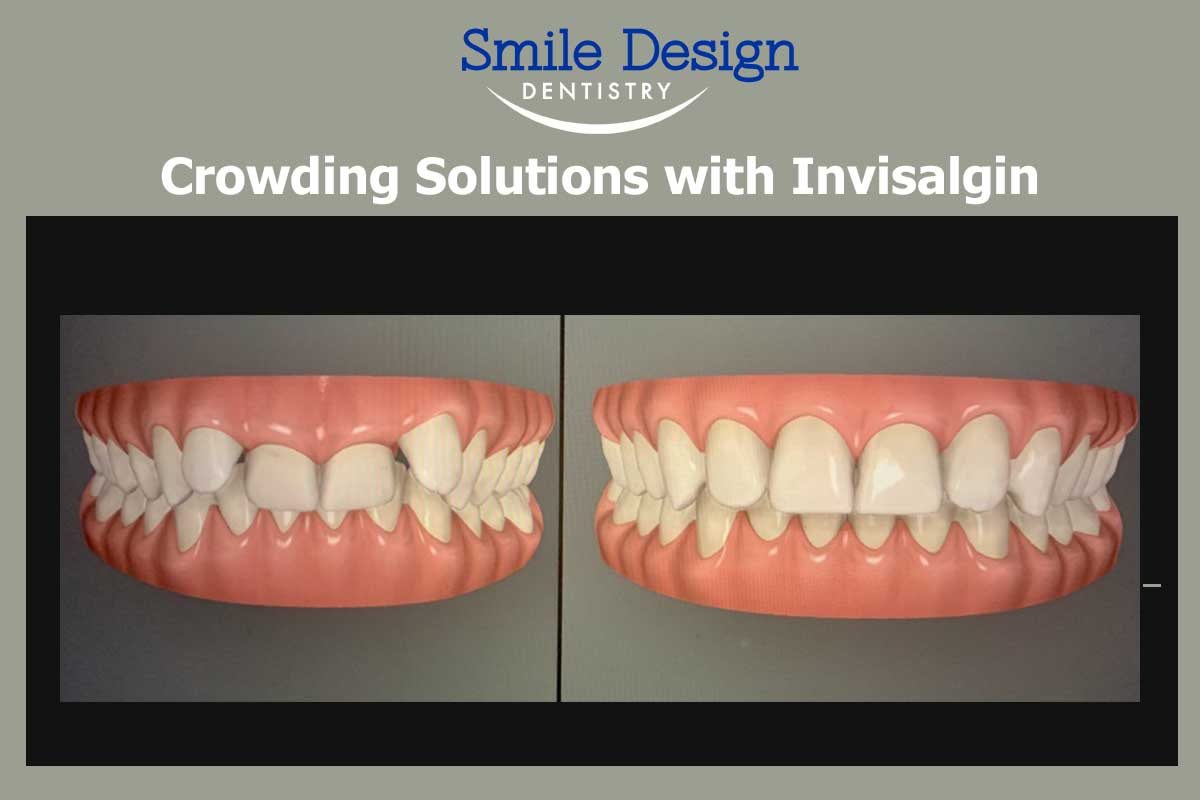
Fix crowded teeth.
Teeth straightening.
Gaps between straight teeth.
A narrow arch or too narrow smile.
May correct a misshaped face.
Make bite adjustments.
Correcting a buccal-lingual crown tip.
Let’s look at each more in-depth.
- Fix Crowded Teeth: Whether mild or severe Invisalign with its Smartforce technology can manage the problem. As the doctor determines the level of crowding, they will consider tipping front teeth out, expanding posterior teeth or reshaping the teeth to create the space required for both alignment and for long term retention. Following this correction is it important for the patient to wear their Invisalign Vivera retainers for lifetime retention.
- Teeth straightening: Invisalign is best known for correcting most cases of crooked teeth. Severely crooked tooth that require a lot of rotation to straighten may need other dental treatment.
- Gaps between straight teeth: Filling small gaps between teeth are fine for Invisalign, but if there are large gaps then Invisalign may not be up to that challenge. Commonly, dental patients wish to close the gaps between some teeth.
- A slanted or canted smile. If you have Occlusal Cant, you are a great candidate for invisalign. It may dramatically change and correct the position of your teeth which will improve the cosmetics greatly.
- A narrow arch or too narrow smile. A common frustration with some people is having a narrow upper arch that does not reveal any back teeth when smiling. Invisalign works well here to broaden the smile and create a nice horseshoe shape that will give a greater reveal of more teeth. With Invisalign it is possible to “widen” a smile. In cases where an arch is not narrow enough to require an expander, or if an expander has already finished its task, the teeth can be straightened to make a smile appear wider.
- May correct a misshaped face. In cases of severely misaligned, receding, or protruding teeth, using Invisalign to adjust the alignment of your teeth may impact the soft tissues laying over them. A person’s cheeks and lips will like conform to the new alignment of your bite, making facial shapes appear more natural.
- Make bite adjustments. The best results from your Invisalign treatment are obtained when your teeth fit and align perfectly when closed top to bottom. By biting down on your tooth chewies a few times each day for 5-10 minutes per time, you will assist seating your aligner, which means the aligner fits tightly against your teeth.
- Correcting a buccal-lingual crown tip: Using Invisalign, “the highest overall accuracy was achieved with a buccal-lingual crown tip (56%)”, according to the American Journal of Orthodontics and Dentofacial Orthopedics. The June 30, 2020 Has Invisalign improved? A prospective follow-up study on the efficacy of tooth movement with Invisalign article headed by Nada Haouili additionally states, “These results are logical, given that the aligner material primarily flexes in a buccal-lingual direction. Furthermore, aligners move teeth by pushing, and the buccal and lingual aspects of the crown provide the largest surface area to push”.
You may now have more questions.
What is Occlusal Cant?
Occlusal Cant is one oral condition that few individuals are aware of. cant. In simplified terms, dentists call it an occlusal cant when the teeth appear to be slanted relative to the nose and lip positions.
What Types of Bite Adjustments are Corrected by Invisalign Aligners?
Here is a list of what bite adjustments Invisalign can fix:
- An overjet bite: A minor overjet can generally be corrected fairly easily with some minor tooth reshaping of the upper back teeth and then retracting the front teeth. In more complex cases doctors will often use a combination of tooth narrowing, rubber band wear and possibly moving all the teeth on the top back. This is a more difficult case and correction can be less predictable.
- An End-to-end bite: This is a common problem that is found in middle aged adults that have a history of grinding and tooth wear. The goal in this situation is to advance the upper teeth and retract the lower teeth to create an ideal overjet so the dentist has space to restore the damaged teeth to their original form and function.
- An overbite: A minor overbite can be predictably corrected with routine Invisalign treatment. As this gets more severe a deepbite may require more aggressive treatment. Cases required severe deepbite correction will involve trying to intrude the front teeth while extruding the back teeth. This is generally aided with Invisalign Bite Tabs added to the back of the upper teeth. Once cause may be thumb sucking.
- An openbite: This can be a complex problem because it is often accompanied by a tongue thrust. Orthodontists have had more success in treating open bites with Invisalign because it can hold the tongue out of the way of movement, adds plastic to the back teeth which need to be intruded and creates a consistent downwards force of the anteriors to close the bite. Typically for success it is best. To also include some form of myofunctional therapy with the Invisalign treatment.
- Crossbites: The fewer teeth involved in crossbite occurrence the more likely a full correction can be made. A full posterior crossbite would be better treated in advance with a different form of mechanical expander. An individual anterior tooth in crossbite has a good prognosis of being fully corrected.
Are there various types of crossbites?
There are 2 different types of crossbites to identify:
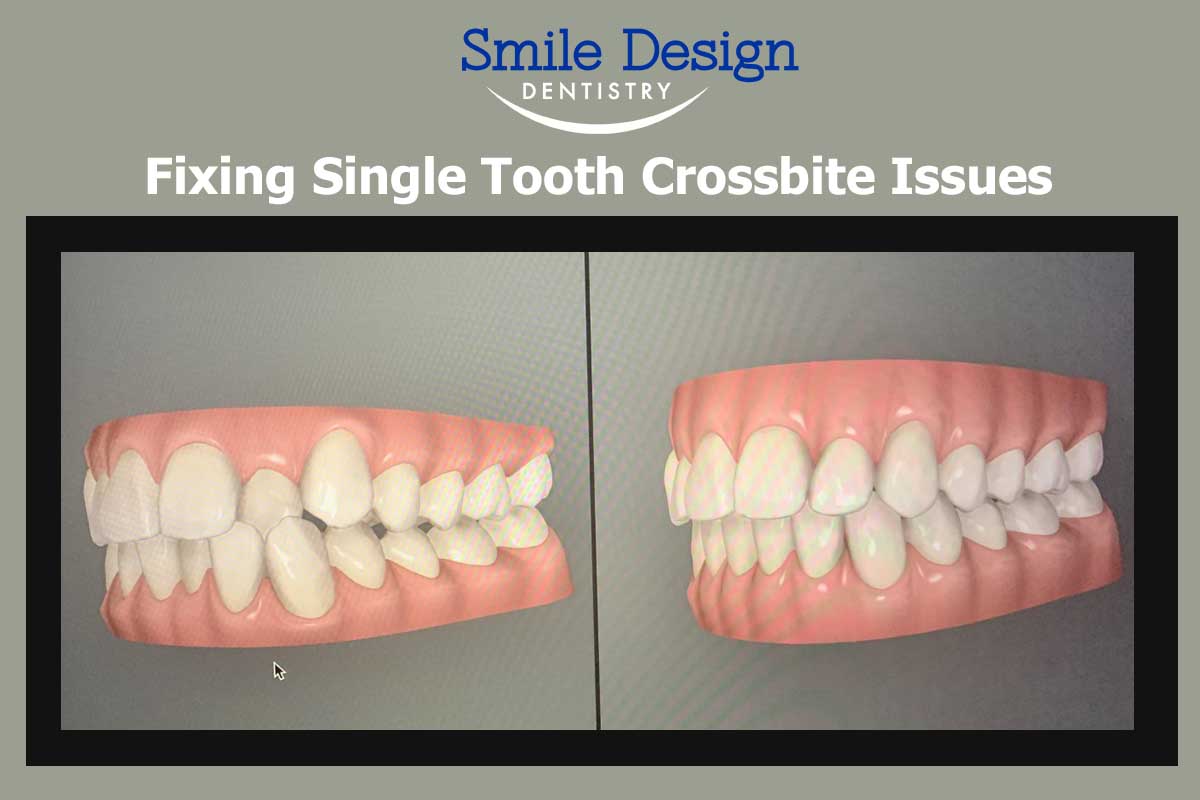
- A Single tooth crossbite: When a single tooth crossbite is encountered, the tooth can be moved with Invisalign braces into the correct position. Single tooth crossbites may occur due to a lack of a person’s primary teeth breaking the gums surface within the usual time frame. This can cause a permanent tooth to erupt in a different eruption pattern which is lingual to the primary tooth a needs correction.
- A Class 3 full anterior crossbite: Several dental treatment options have been proposed for these types of corssbite cases, including tooth extractions, which is “usually premolars in the lower or both arches, extraoral traction (horizontal traction of the mandibular arch, or vertical traction in an open-bite case), and distalization of lower molars with devices such as lip bumpers. The use of an expansion device following a midline maxillary osteotomy has been advocated for treatment of the crossbite that is commonly found in non-growing Class III patients,” according to the Journal of Clinical Orthodontics.
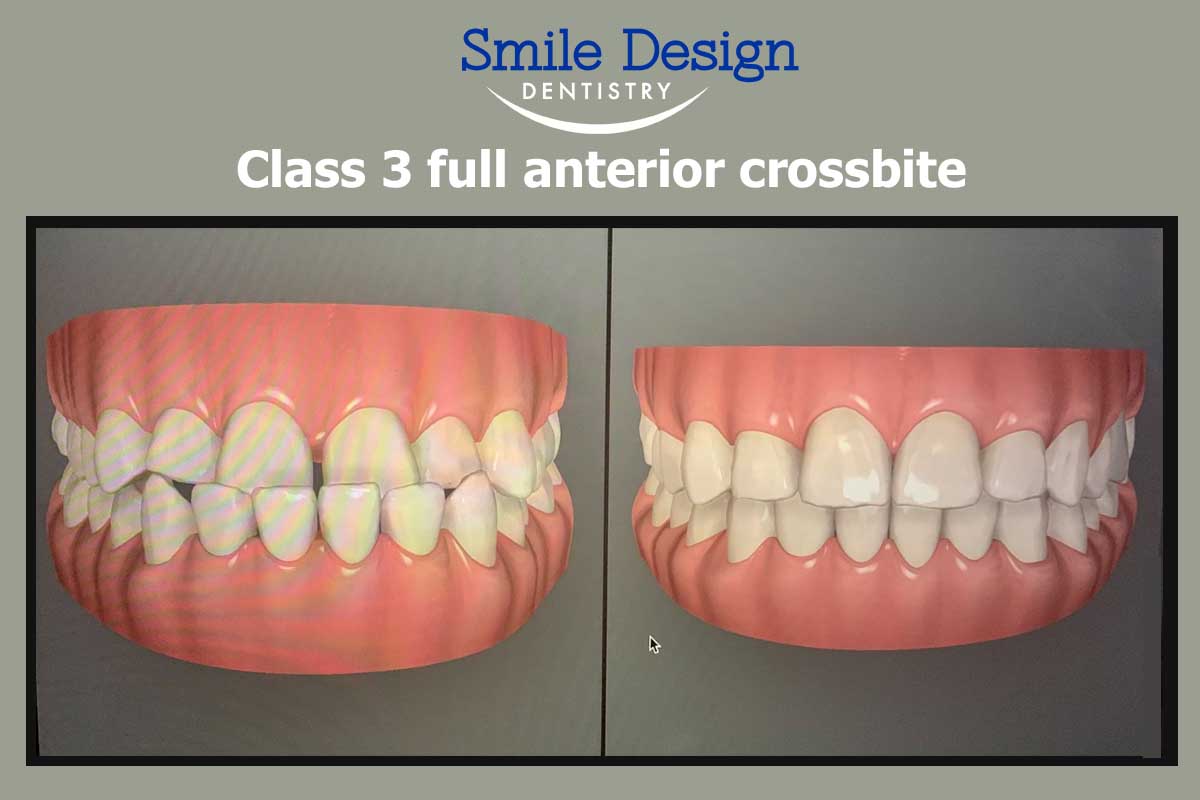
Why is Aligner Therapy Considered better than Traditional Braces?
- The most obvious advantage to aligner therapy is not having braces bonded to your teeth.
- Being able to remove your aligners for meals makes eating easier and more enjoyable.
- Oral hygiene is much easier not having to brush around all of the brackets and wires. For many teenagers who are not maintaining their hygiene as they should this will greatly reduce the risk of damage to the teeth during treatment.
- Discomfort appears to be reported much less with patients using aligners compared to patients with braces.
- Treatment is very efficient. By changing aligners on a weekly basis there is consistent movement which generally reduces the time in treatment.
- There are very few reports of tooth root resorption occurring while using aligners which can be more common with traditional braces.
- Aligners are more socially accepted than traditional braces which during the difficult adolescent stage can be very important.
When isn’t an Invisalign Smile Correction the Best Option?
1. Invisalign requires a very compliant patient. Without excellent wear treatment will not work. Our dental patients who can follow-through with proper care during treatment use our comprehensive Guidelines for Invisalign Aligner Care.
2. Some required tooth movements are not well achieved with aligner therapy. Examples might include bringing down impacted teeth or rotating severely rotated teeth.
3. Some people just feel that traditional braces are easier than having to deal with aligners.
Is Invisalign Treatment Being Used More or Less?
Invisalign smile corrections are on the rise. Fast forward to late 2020 – deep into the new world of COVID-19 – we are seeing something occur in the world of Invisalign that no one would have predicted. As more people are now working from home and working via video conferencing, we are basically looking in a mirror at our smile all day long. This is being termed the “ZOOM EFFECT”.
The interest in straight teeth and mending gummy smiles has skyrocketed to a level never seen in history. It could be argued that this would not have occurred if we only had traditional braces to offer our patients.
What are the Steps in Getting Invisalign Started?
At Smile Design Dentistry in Plymouth Minnesota we always begin Invisalign adjustments with the following:
- A free consultation to identify the issues and to understand the patient’s goals.
- Once the initial discussion has occurred and the patient feels comfortable with proceeding, the next step is to acquire orthodontic records. Our records consist of a Planmeca Romexis full-field CBCT image, a panographic x-ray, a series of Orthodontic photographs and a 3-D Itero Elements digital scan.
- In addition, we complete an orthodontic diagnostic form and then begin fabrication of our prescription.
- All of this information is sent to Invisalign where a plan is created known as an Invisalign Clincheck. It is here where the doctor gets to make their adjustments to create their final plan before the case is sent to production.
- Once approved, the Invisalign company will 3D print all of the aligners designed to complete the case. These aligners are generally delivered in 2-3 weeks and we are ready to begin treatment.
How does Invisalign Actually Correct Someone’s Smile?
Invisalign has created a complex dental technology that using 7 + million cases in the past can best predict how to move the teeth. It also determines at what rate to move the teeth and in what order the teeth need to be moved. The computer will design a program that will efficiently divide these movements up over a series of aligners. Smile Design Dentistry in Plymouth, MN, uses 3D imaging (CBCT scanning) to design a unique treatment plan.
When an aligner is first placed generally the patient reports that they feel a little tightness. Over the course of the 1 week of wear the patient will notice that the aligner begins to feel like it is fitting passively. As they move up the progression of aligners, they will feel this recurring tightness and slowly begin to notice their bite change and their teeth move.
Why me, why should I start an Invisalign correction now?
Well first of all you owe it to yourself. It has never been faster, easier or less expensive to have your teeth aligned. Have you caught yourself on a Zoom call thinking your teeth are not looking so good? We see a very large increase in the number of patients seeking care and a new smile design.
We are commonly hearing “it’s a perfect time to do it – I’m always wearing a mask,” We also are hearing, “I not spending money on travel or entertainment now so I just as well get it done.” Check your insurance. Chances are good that you have coverage that will help you with a big portion of the expense.
CONCLUSION
Invisible aligners fix many issues with your teeth and smile. Orthodontic treatments improve a person’s quality of life.
It is hard to put a price on a beautiful smile – do yourself a favor. We treat each individual dental patient based on his or her own personal expectations, combined with our professional advice. Agreeing on your dental plan together sets the stage for amazing life-long smiles.
Ask your dentist or orthodontist; the doctors at Smile Design Dentistry would love to help.
Call 763-537-1238 or book your dental appointment today!
 Dr. Corey Jensen is a lead dentist at Smile Design Dentistry in Plymouth, Minnesota. Dr. Jensen has accumulated over 2400 additional hours of advanced education in his continued pursuit of excellence. He has received the highest distinction of “Master” in the Academy of General Dentistry and has been repeatedly recognized by his peers as a “Hall of Fame -Top Dentist” in the Mpls/St.Paul magazine.
Dr. Corey Jensen is a lead dentist at Smile Design Dentistry in Plymouth, Minnesota. Dr. Jensen has accumulated over 2400 additional hours of advanced education in his continued pursuit of excellence. He has received the highest distinction of “Master” in the Academy of General Dentistry and has been repeatedly recognized by his peers as a “Hall of Fame -Top Dentist” in the Mpls/St.Paul magazine.


